Theoretical and Experimental Investigation on the 3D Surface Roughness of Material Extrusion Additive Manufacturing Products
Abstract
:1. Introduction
2. Analytical Study
2.1. Analytical Investigation Based on Horizontal Bonding Neck
2.1.1. The Surface Roughness Vertical to the Fiber Direction
2.1.2. The Surface Roughness Parallel to the Fiber Direction
2.2. Analytical Investigation Based on Longitudinal Bonding Neck
2.2.1. The Surface Roughness Vertical to the Fiber Direction
2.2.2. The Surface Roughness Parallel to the Fiber Direction
3. Experimental Analysis
3.1. Sample Preparation
3.2. Surface Roughness Test
4. Results and Discussions
4.1. Results Based on the Horizontal Bonding Neck
4.1.1. Surface Roughness Vertical to the Fiber Direction (SRVF)
4.1.2. Surface Roughness Parallel to the Fiber Direction (SRPF)
4.2. Results Based on the Longitudinal Bonding Neck
4.2.1. Surface Roughness Vertical to the Fiber Direction (SRVF)
4.2.2. Surface Roughness Parallel to the Fiber Direction (SRPF)
5. Sensitivity Analysis
5.1. Effect of Extrusion Width
5.2. Effect of Layer Thickness
5.3. Effect of Extrusion Temperature
5.4. Influencing Degree of the Processing Parameters
6. Conclusions
Author Contributions
Funding
Institutional Review Board Statement
Informed Consent Statement
Data Availability Statement
Conflicts of Interest
References
- Lang, A.; Segonds, F.; Jean, C.; Gago, C.; Guegan, J.; Buisine, S.; Mantelet, F. Augmented design with additive manufacturing methodology: Tangible object-based method to enhance creativity in design for additive manufacturing. 3D Print. Addit. Manuf. 2021, 8, 281–292. [Google Scholar] [CrossRef]
- Ponche, R.; Kerbrat, O.; Mognol, P.; Hascoet, J.Y. A novel methodology of design for additive manufacturing applied to additive laser manufacturing process. Robot. Comput.-Integr. Manuf. 2014, 30, 389–398. [Google Scholar] [CrossRef] [Green Version]
- Zhao, C.; Parab, N.; Li, X.X.; Fezzaa, K.; Tan, W.; Rollett, A.; Sun, T. Critical instability at moving keyhole tip generates porosity in laser melting. Science 2020, 370, 1080–1086. [Google Scholar] [CrossRef] [PubMed]
- Jiang, J.C.; Xu, X.; Stringer, J. Optimization of process planning for reducing material waste in extrusion based additive manufacturing. Robot. Comput.-Integr. Manuf. 2019, 59, 317–325. [Google Scholar] [CrossRef]
- Ngo, T.D.; Kashani, A.; Imbalzano, G.; Ngyen, T.Q.; Hui, D. Additive manufacturing (3D printing): A review of materials, methods. Appl. Chall. Compos. Part B Eng. 2018, 143, 172–196. [Google Scholar] [CrossRef]
- Ford, S.; Despeisse, M. Additive manufacturing and sustainability: An exploratory study of the advantages and challenges. J. Clean. Prod. 2016, 137, 1573–1587. [Google Scholar] [CrossRef]
- Priya, M.S.; Naresh, K.; Jayaganthan, R.; Velmurugan, R. A comparative study between in-house 3D printed and injection molded ABS and PLA polymers for low-frequency applications. Mater. Res. Express 2019, 6, 1–22. [Google Scholar]
- Bikas, H.; Stavropoulos, P.; Chryssolouris, G. Additive manufacturing methods and modelling approaches: A critical review. Int. J. Adv. Manuf. Technol. 2016, 83, 389–405. [Google Scholar] [CrossRef] [Green Version]
- Vyavahare, S.; Kumar, S.; Panghal, D. Experimental study of surface roughness, dimensional accuracy and time of fabrication of parts produced by fused deposition modelling. Rapid Prototyp. J. 2020, 26, 1535–1554. [Google Scholar] [CrossRef]
- Sammaiah, P.; Rushmamanisha, K.; Praveenadevi, N.; Reddy, I.R. The influence of process parameters on the surface roughness of the 3d printed part in FDM process. IOP Conf. Ser. Mater. Sci. Eng. 2020, 981, 042021. [Google Scholar] [CrossRef]
- Buj-Corral, I.; Dominguez-Fernandez, A.; Duran-Llucia, R. Influence of print orientation on surface roughness in fused deposition modeling (FDM) processes. Materials 2019, 12, 3834. [Google Scholar] [CrossRef] [PubMed] [Green Version]
- Nancharaiah, T.; Raju, D.R.; Raju, V.R. An experimental investigation on surface quality and dimensional accuracy of FDM components. Int. J. Emerg. Technol. 2010, 1, 106–111. [Google Scholar]
- Lalehpour, A.; Barari, A. A more accurate analytical formulation of surface roughness in layer-based additive manufacturing to enhance the product’s precision. Int. J. Adv. Manuf. Technol. 2018, 96, 3793–3804. [Google Scholar] [CrossRef]
- Vahabli, E.; Rahmati, S. Hybrid estimation of surface roughness distribution in FDM parts using analytical modeling and empirical investigation. Int. J. Adv. Manuf. Technol. 2016, 88, 2287–2303. [Google Scholar] [CrossRef]
- Ahn, D.K.; Kwon, S.M.; Lee, S.H. Expression for surface roughness distribution of FDM processed. In Proceedings of the 2008 International Conference on Smart Manufacturing Application, Goyangi, Korea, 9–11 April 2008; pp. 490–493. [Google Scholar]
- Campbell, R.I.; Martorelli, M.; Lee, H.S. Surface roughness visualisation for rapid prototyping models. Comput.-Aided Des. 2002, 34, 717–725. [Google Scholar] [CrossRef]
- Angelo, L.D.; Stefano, P.D.; Marzola, A. Surface quality prediction in FDM additive manufacturing. Int. J. Adv. Manuf. Technol. 2017, 93, 3655–3662. [Google Scholar] [CrossRef]
- Ahn, D.; Kweon, J.H.; Kwon, S.; Song, J.; Lee, S. Representation of surface roughness in fused deposition modeling. J. Mater. Process. Technol. 2009, 209, 5593–5600. [Google Scholar] [CrossRef]
- Ahn, D.; Kim, H.; Lee, S. Surface roughness prediction using measured data and interpolation in layered manufacturing. J. Mater. Process. Technol. 2009, 209, 664–671. [Google Scholar]
- Li, Z.X.; Zhang, Z.Y.; Shi, J.C.; Wu, D.Z. Prediction of surface roughness in extrusion-based additive manufacturing with machine learning. Robot. Comput.-Integr. Manuf. 2019, 57, 488–495. [Google Scholar] [CrossRef]
- Wang, P.; Zou, B.; Ding, S.L. Modeling of surface roughness based on heat transfer considering diffusion among deposition filaments for FDM 3D printing heat-resistant resin. Appl. Therm. Eng. 2019, 161, 1–12. [Google Scholar] [CrossRef]
- Kaji, F.; Barari, A. Evaluation of the surface roughness of additive manufacturing parts based on the modelling of cusp geometry. IFAC-PapersOnLine 2015, 48, 658–663. [Google Scholar] [CrossRef]
- Li, L.; Haghighi, A.; Yang, Y.R. Theoretical modelling and prediction of surface roughness for hybrid additive–subtractive manufacturing processes. IISE Trans. 2018, 51, 124–135. [Google Scholar] [CrossRef]
- Pandey, P.M.; Reddy, N.V.; Dhande, S.G. Real time adaptive slicing for fused deposition modelling. Int. J. Mach. Tools Manuf. 2003, 43, 61–71. [Google Scholar] [CrossRef]
- Taufik, M.; Jain, P.K. A study of suild edge profile for prediction of surface roughness in fused deposition modeling. J. Manuf. Sci. Eng. 2016, 138, 1–11. [Google Scholar] [CrossRef]
- Vanaei, H.R.; Shirinbayan, M.; Vanaei, S.; Fitoussi, J.; Khelladi, S.; Tcharkhtchi, A. Multi-scale damage analysis and fatigue behavior of PLA manufactured by fused deposition modeling (FDM). Rapid Prototyp. J. 2021, 27, 371–378. [Google Scholar] [CrossRef]
- Vanaei, H.R.; Raissi, K.; Deligant, M.; Shirinbayan, M.; Raissi, K.; Fitoussi, J.; Khelladi, S.; Tcharkhtchi, A. Toward the understanding of temperature effect on bonding strength, dimensions and geometry of 3D-printed parts. J. Mater. Sci. 2020, 55, 14677–14689. [Google Scholar] [CrossRef]
- Vanaei, H.R.; Deligant, M.; Shirinbayan, M.; Raissi, K.; Fitoussi, J.; Khelladi, S.; Tcharkhtchi, A. A comparative in-process monitoring of temperature profile in fused filament fabrication. Polym. Eng. Sci. 2020, 61, 68–76. [Google Scholar] [CrossRef]
- Vanaei, H.R.; Shirinbayan, M.; Deligant, M.; Khelladi, S.; Tcharkhtchi, A. In-process monitoring of temperature evolution during fused filament fabrication: A journey from numerical to experimental approaches. Thermo 2021, 1, 332–360. [Google Scholar] [CrossRef]
- Abbott, A.C.; Tandon, G.P.; Bradford, R.L.; Koerner, H.; Baur, J.W. Process-structure-property effects on ABS bond strength in fused filament fabrication. Addit. Manuf. 2018, 19, 29–38. [Google Scholar] [CrossRef]
- Frenkel, Y.I. Viscous flow of crystalline bodies under the action of surface tension. Sci. Sinter. 1980, 12, 7–18. [Google Scholar]
- Pokluda, O.; Bellehumeur, C.; Vlachopoulos, J. Modification of frenkel’s model for sintering. Aiche J. 1997, 43, 3253–3256. [Google Scholar] [CrossRef]
- Jiang, S.J.; Chen, P.F.; Sun, M.Y.; Dong, T.K. Theoretical study on the apparent viscosity of melt inside the fused filament fabrication extrusion liquefier under vibration field. J. Northeast. Univ. 2021, 43, 395–400. [Google Scholar]
- Bellehumeur, C.; Li, L.M.; Sun, Q.; Gu, P.H. Modeling of bond formation between polymer filaments in the fused deposition modeling process. J. Manuf. Processes 2004, 6, 170–178. [Google Scholar] [CrossRef]
- Farah, S.; Anderson, D.G.; Langer, R. Physical and mechanical properties of PLA, and their functions in widespread applications-A comprehensive review. Adv. Drug Deliv. Rev. 2016, 107, 367–392. [Google Scholar] [CrossRef] [PubMed] [Green Version]
- Nagalingam, A.P.; Vohra, M.S.; Kapur, P.; Yeo, S.H. Effect of Cut-Off, Evaluation length, and measurement area in profile and areal surface texture characterization of as-built metal additive manufactured components. Appl. Sci. 2021, 11, 5089. [Google Scholar] [CrossRef]
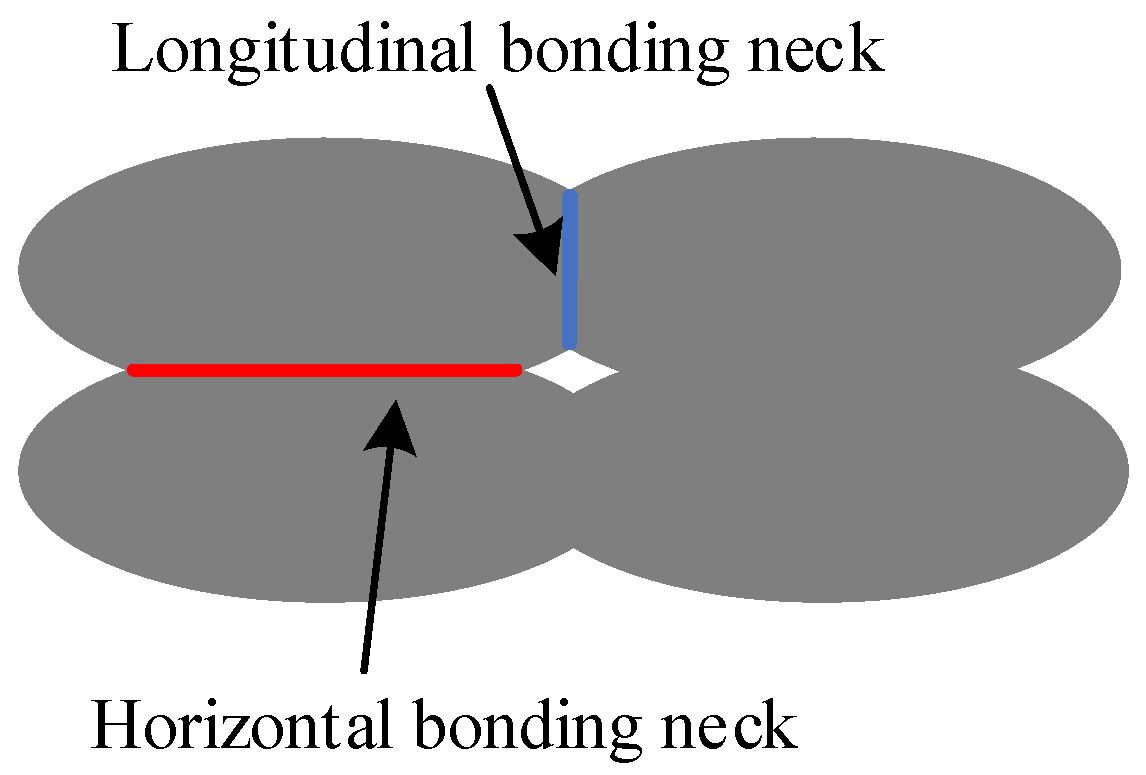

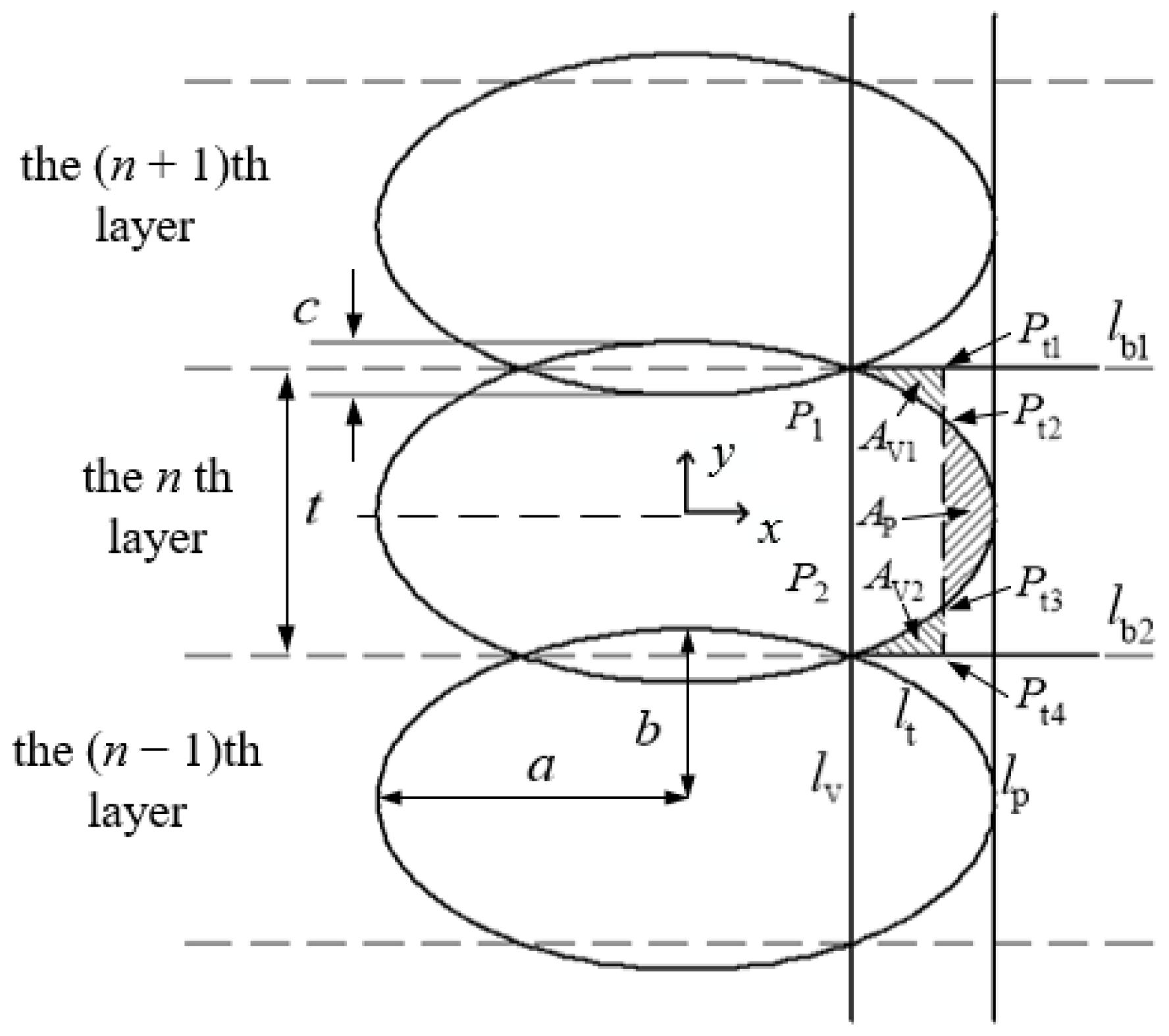
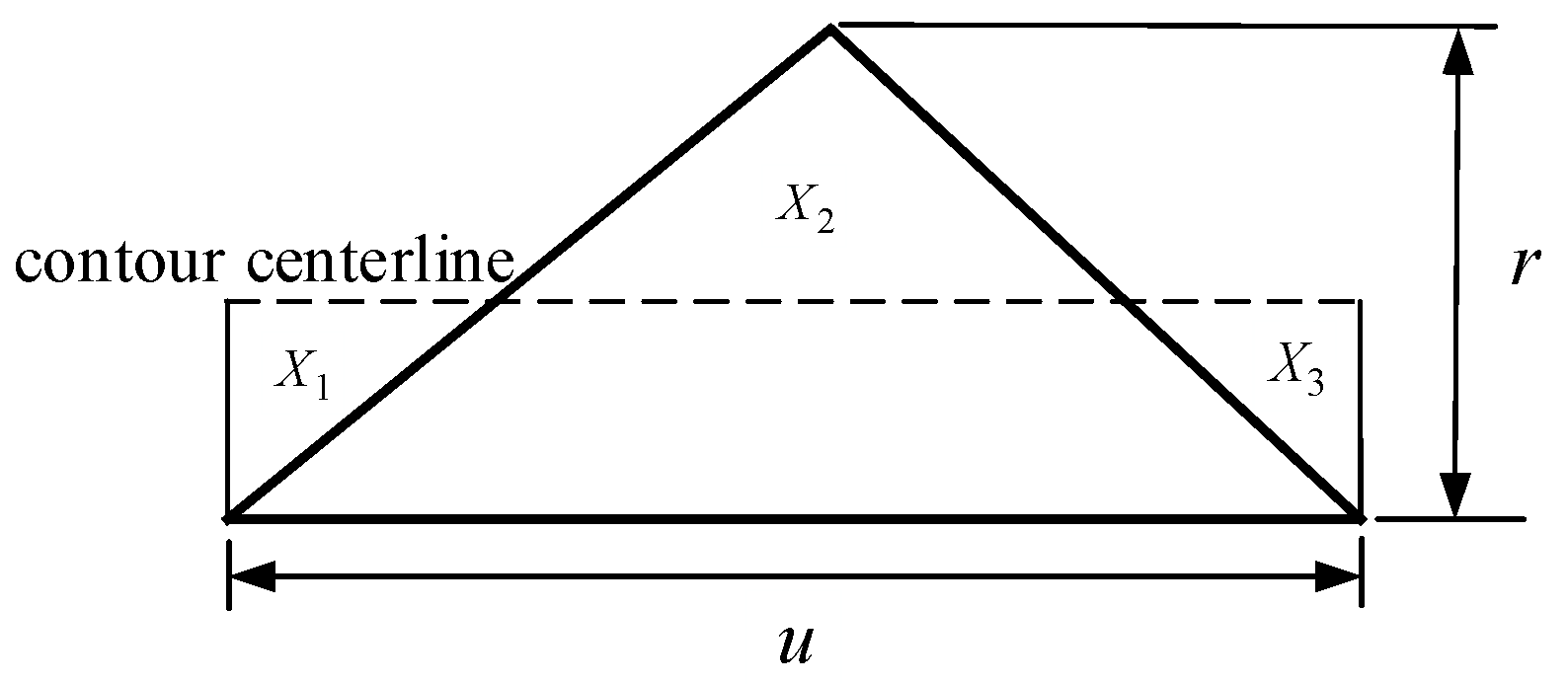



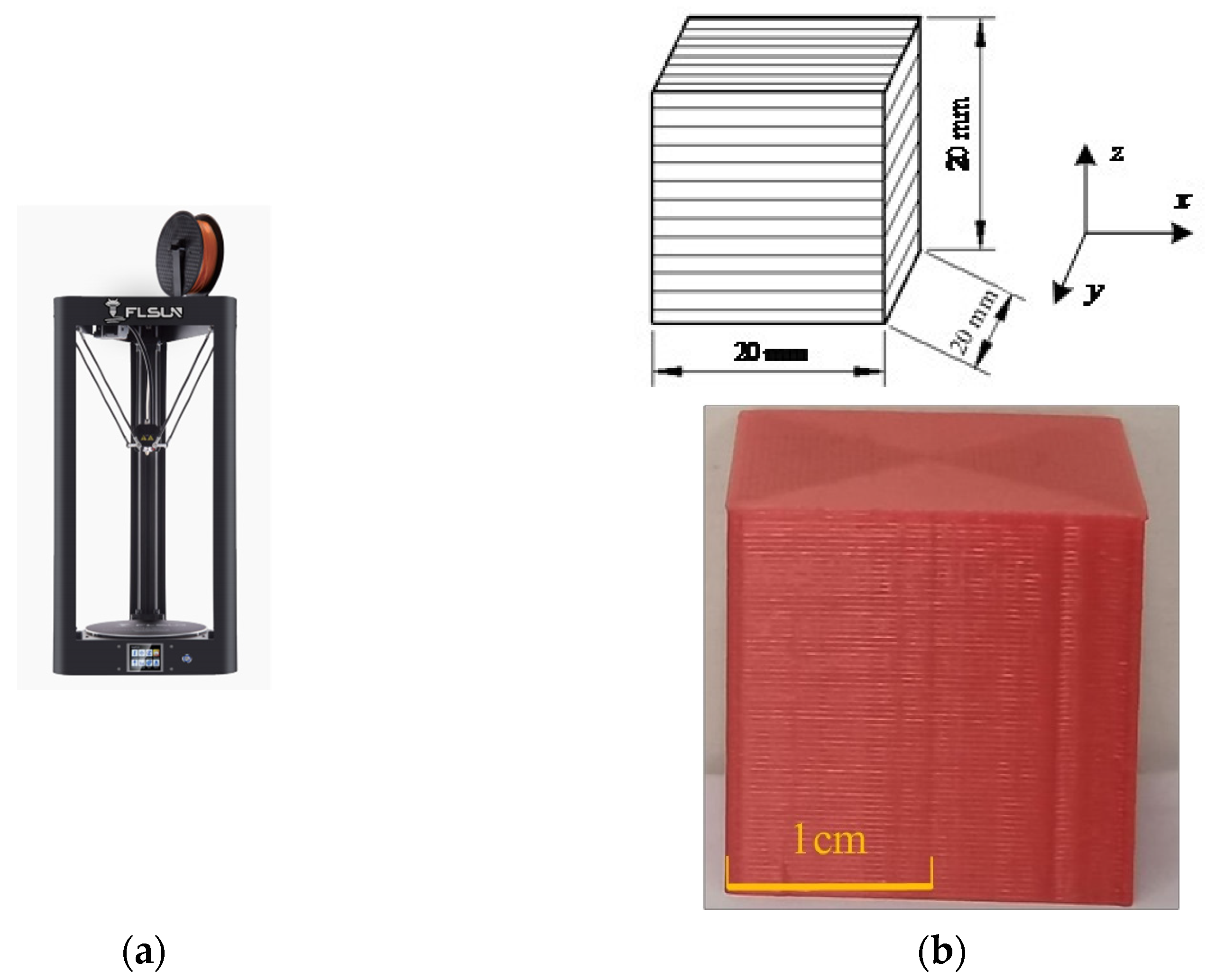
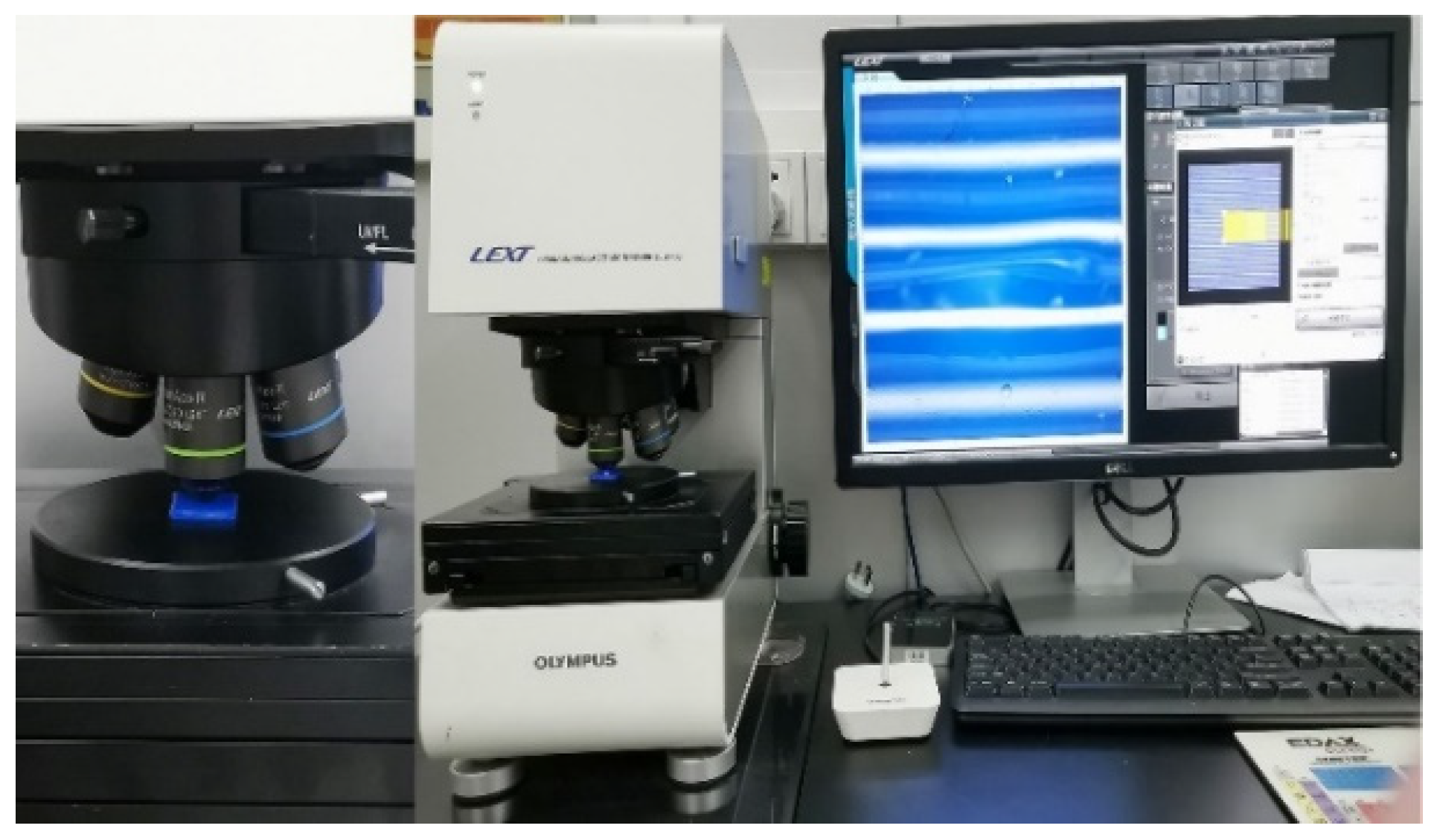
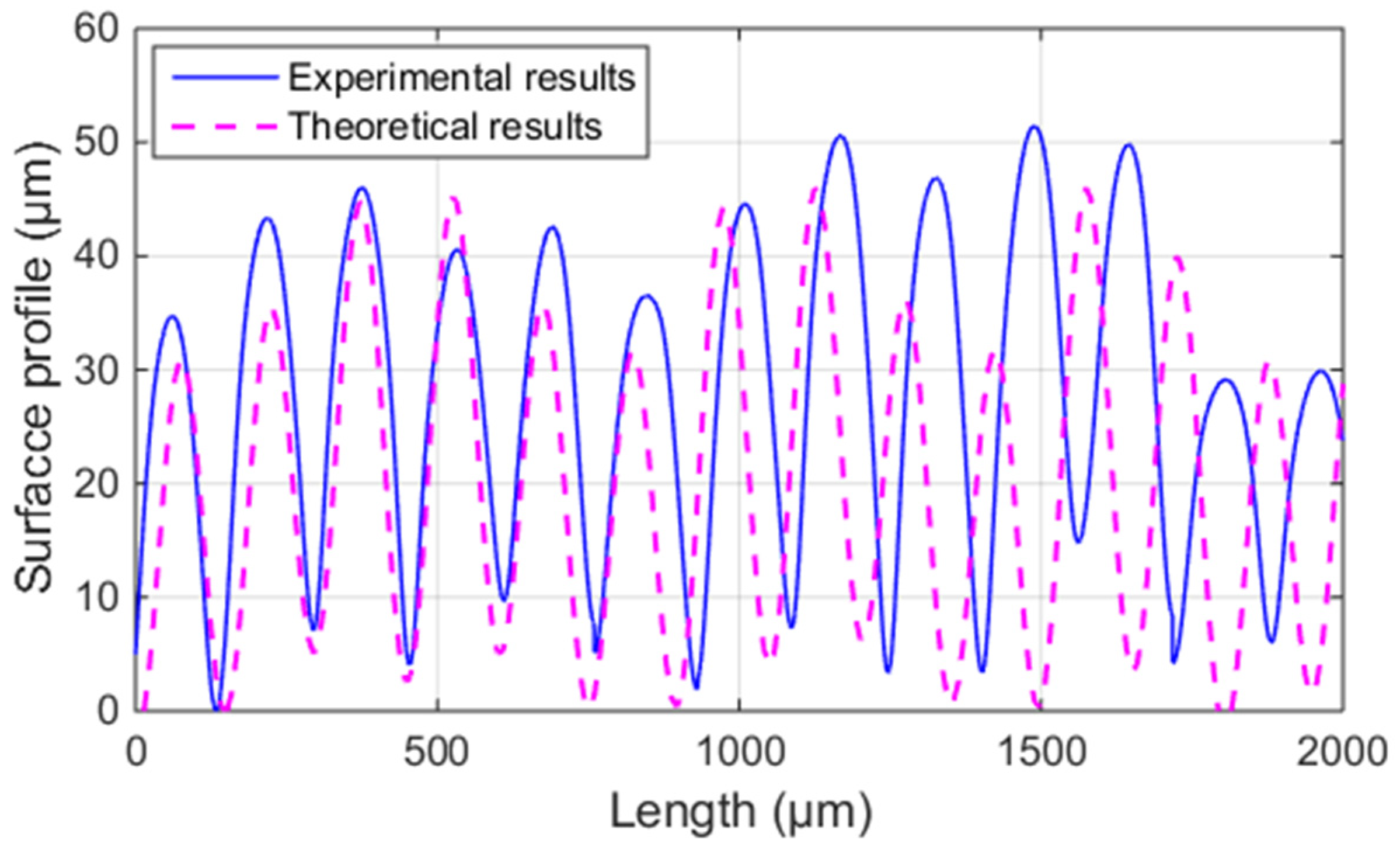
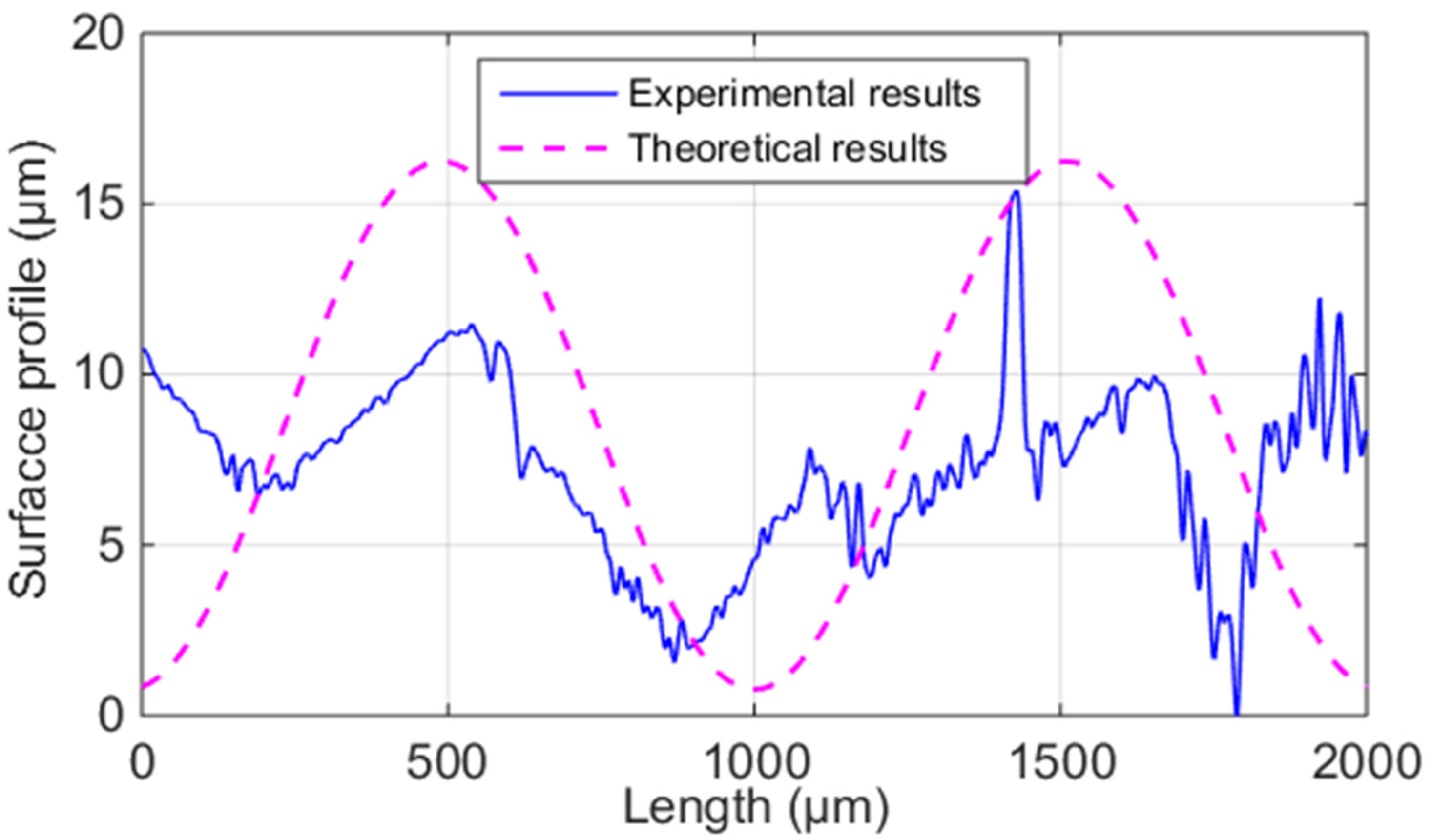
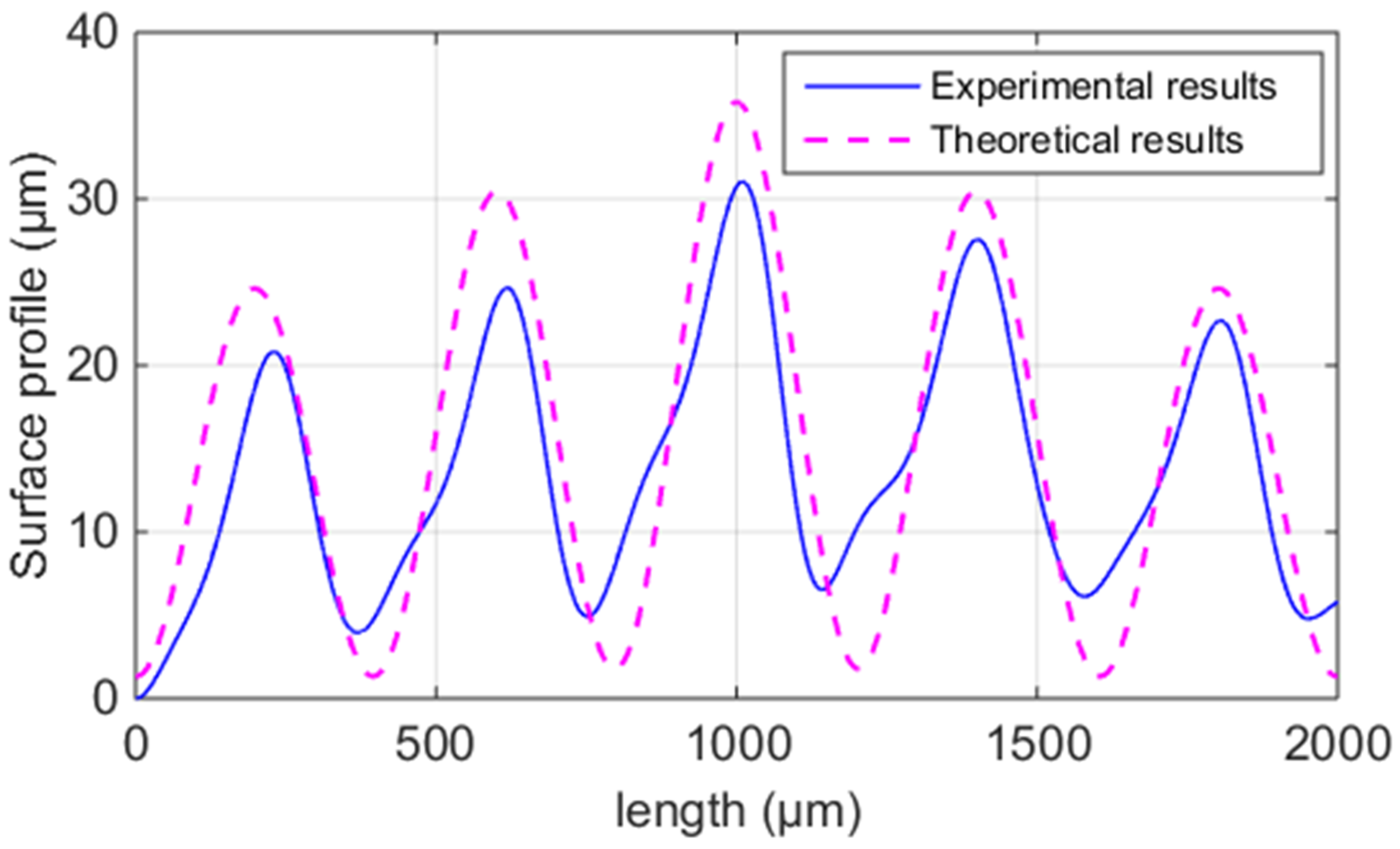

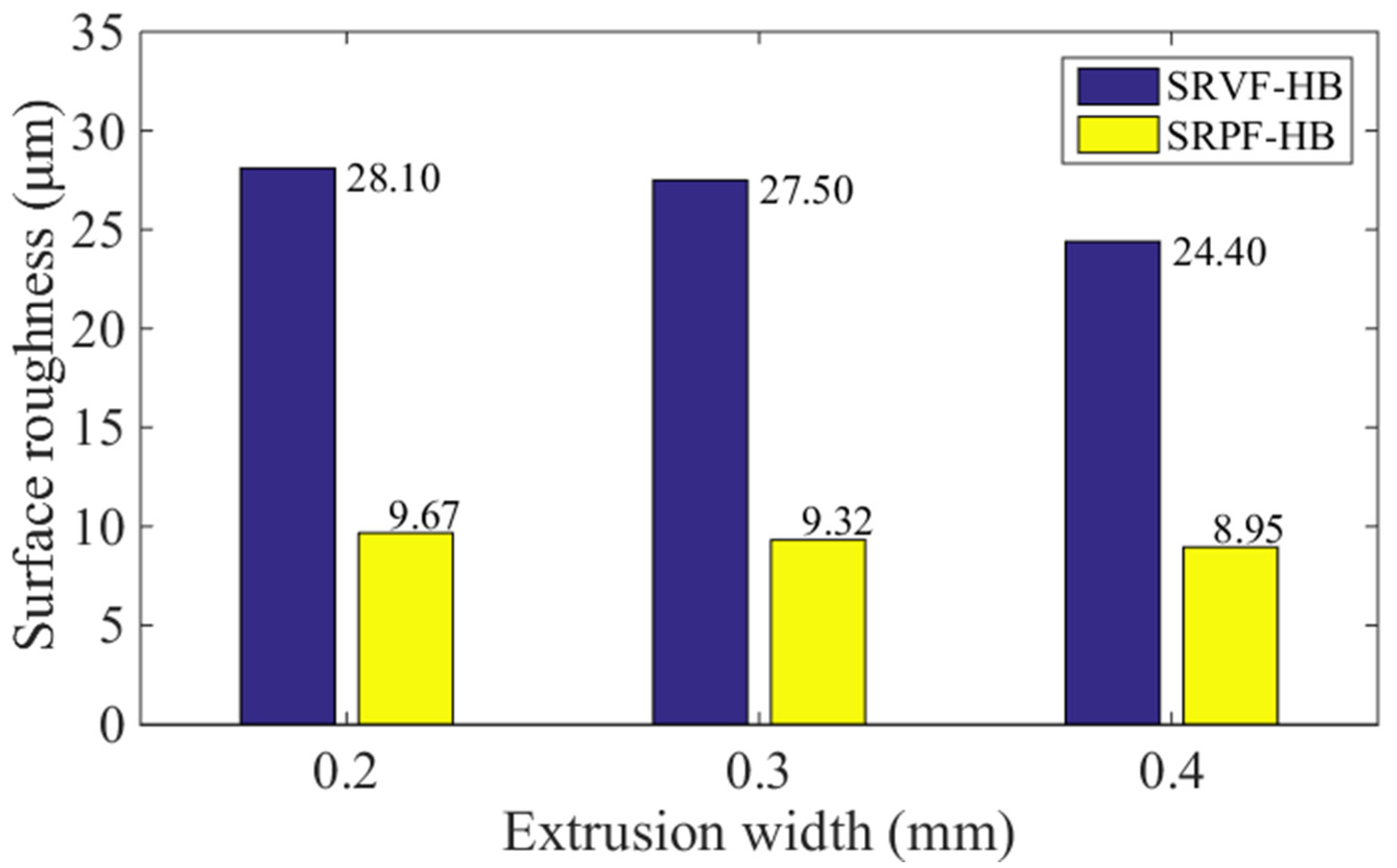
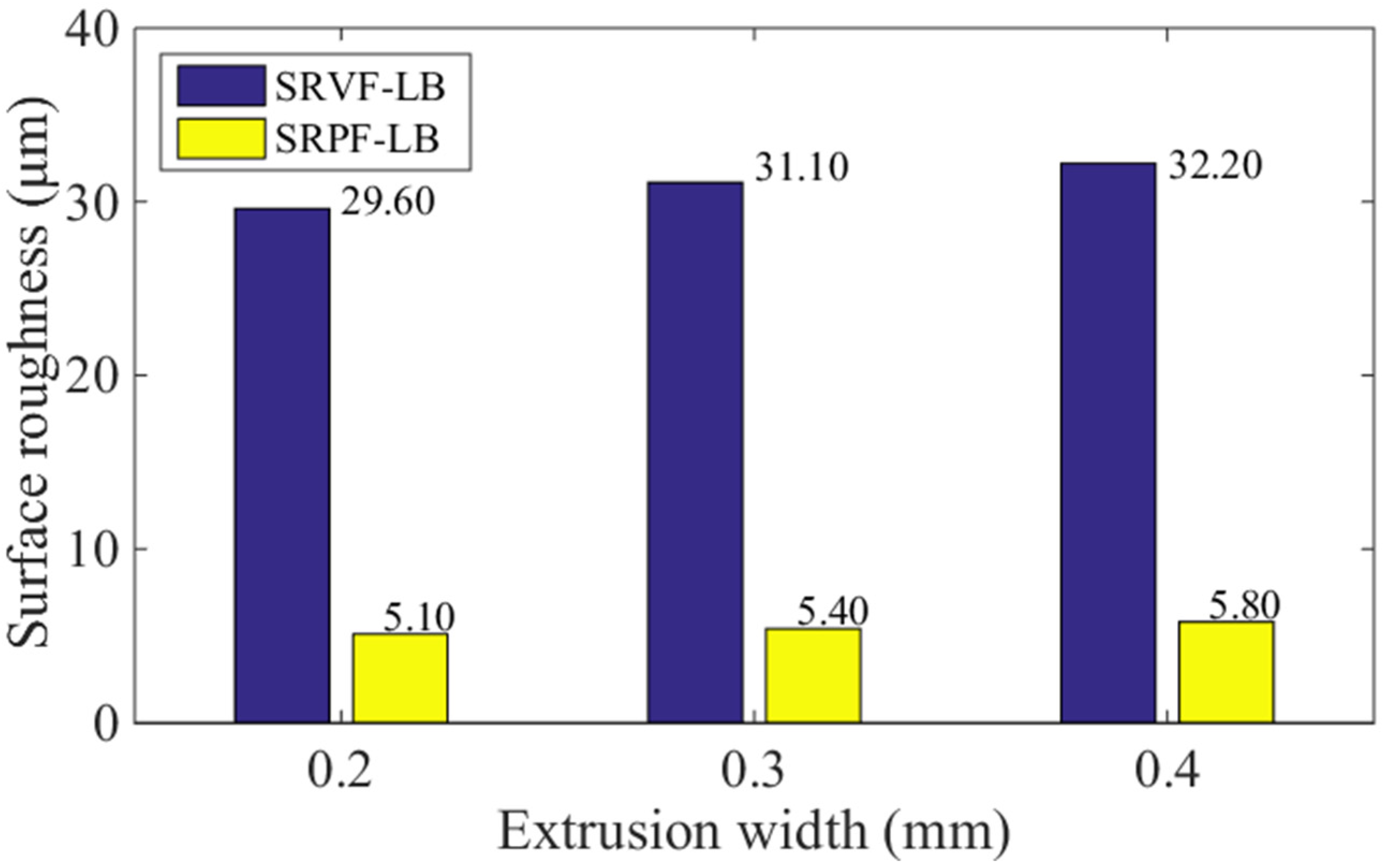

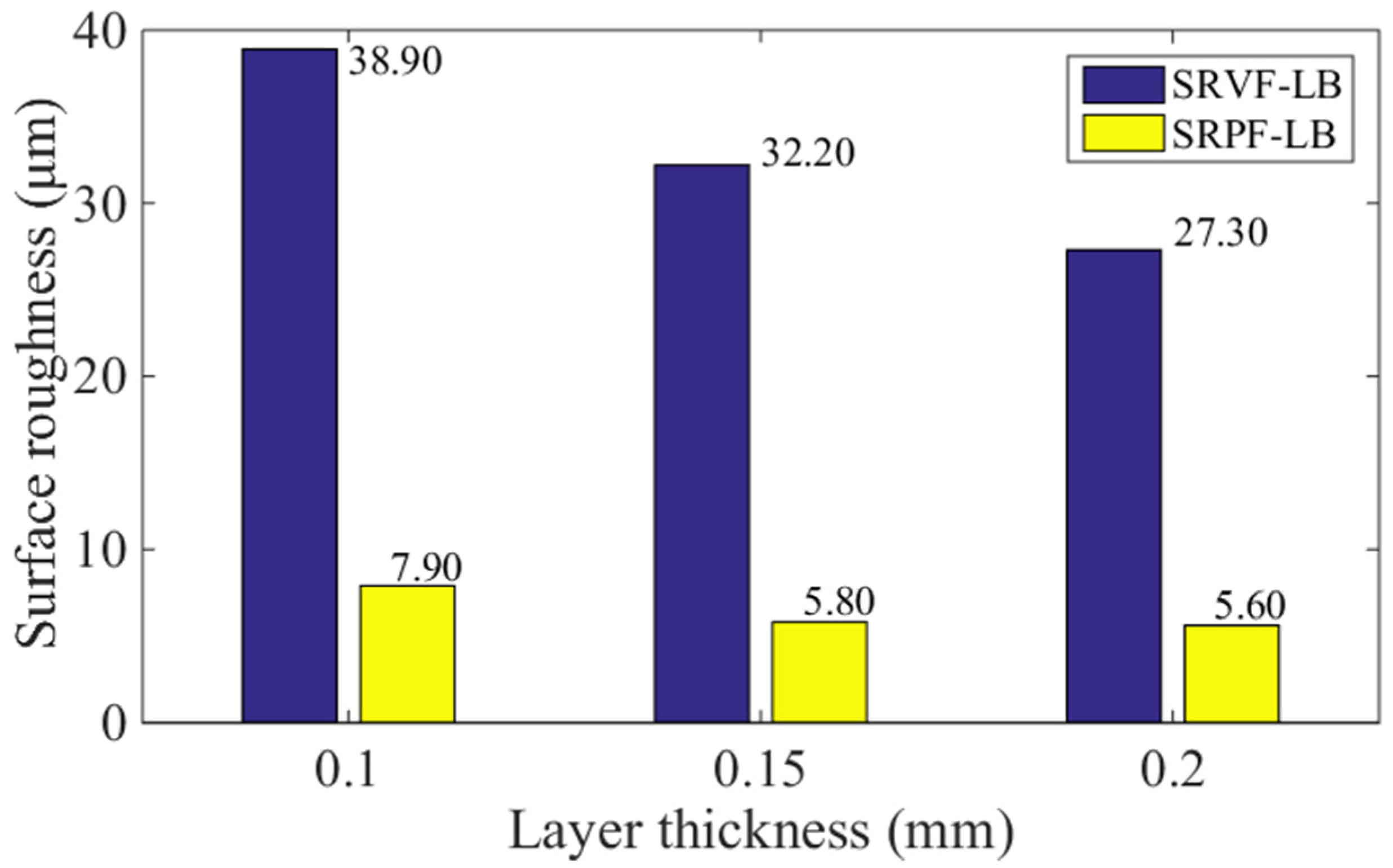
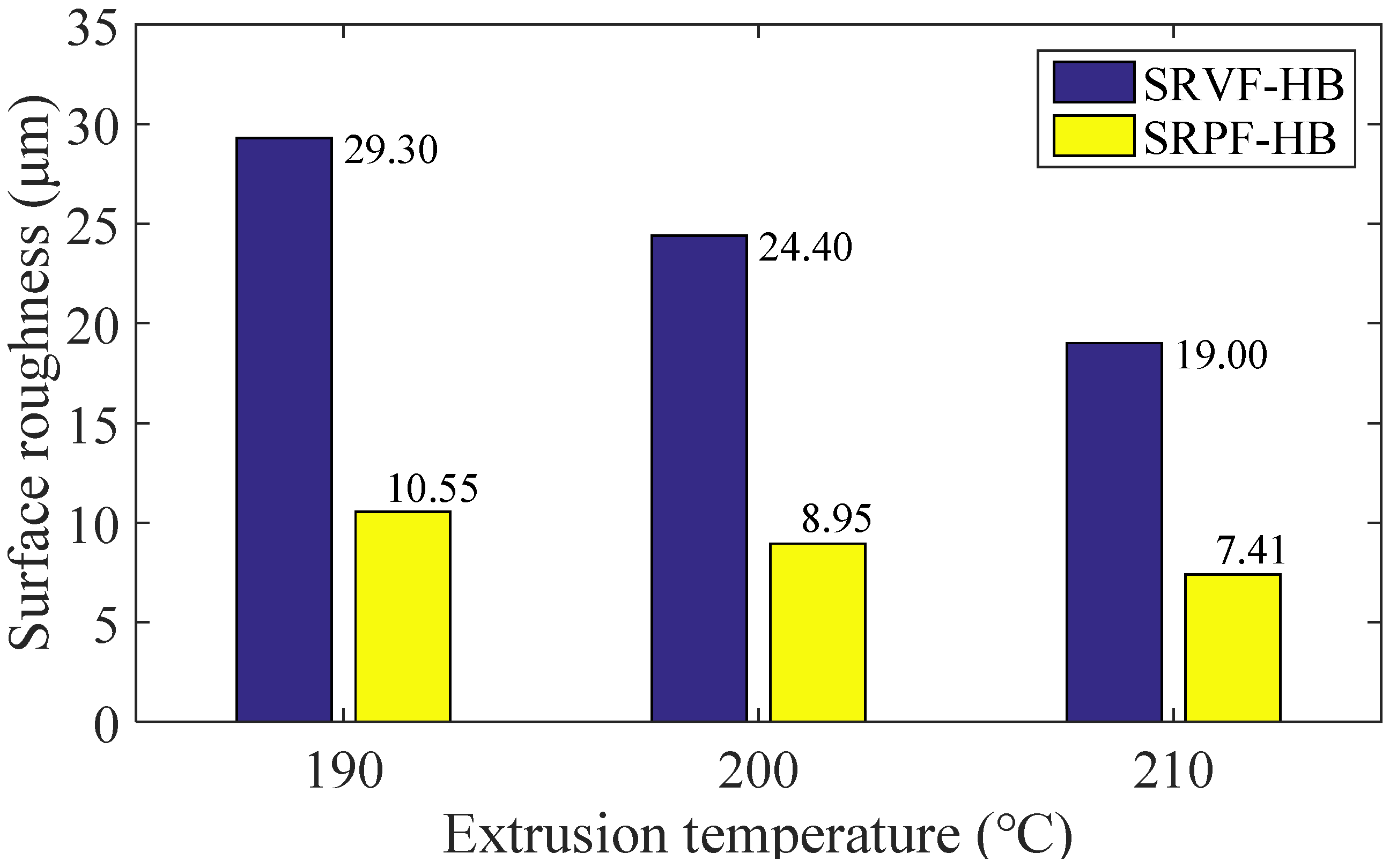
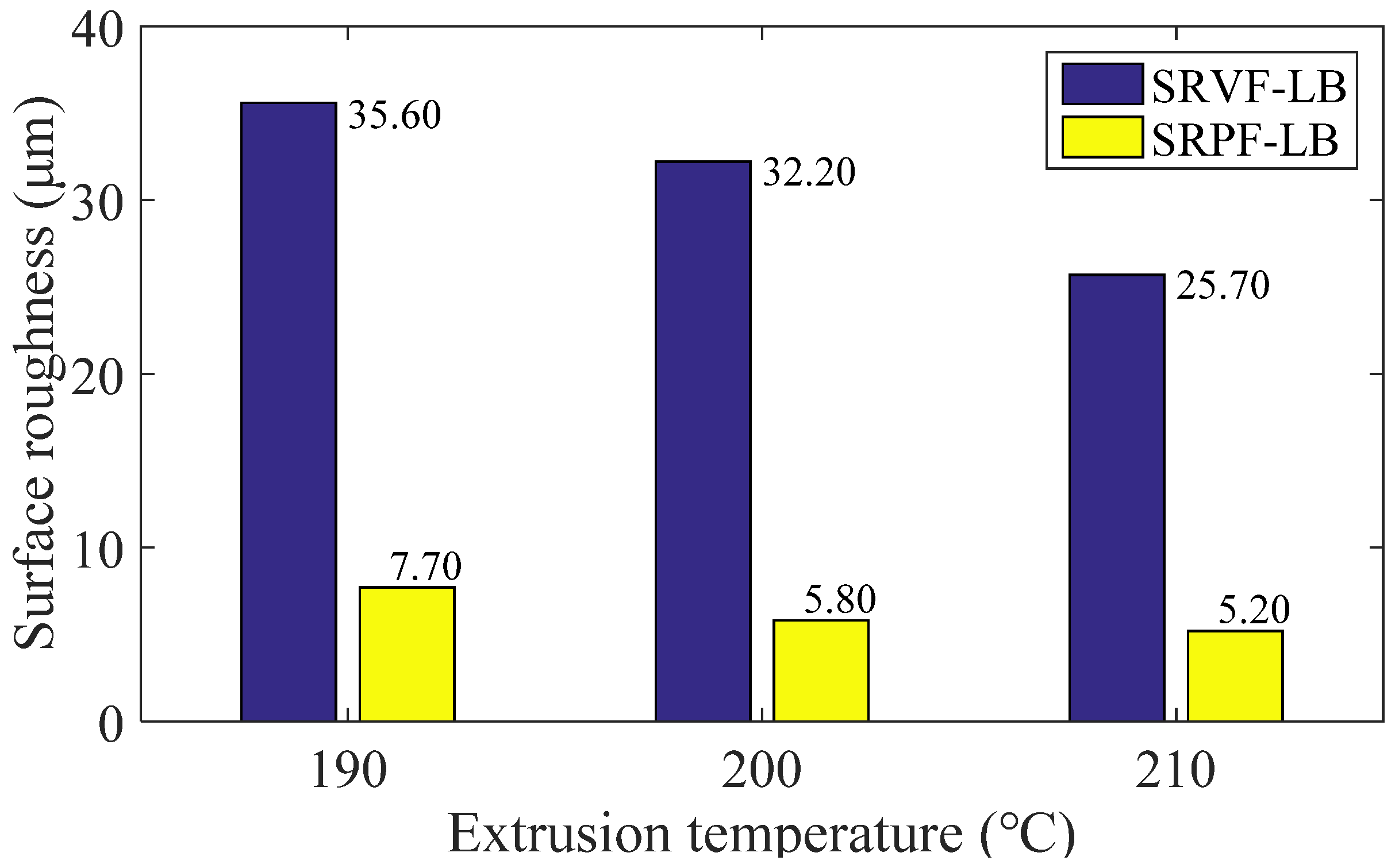
| Category | Schematic Diagram |
|---|---|
| Based on horizontal bonding neck |  |
| Based on longitudinal bonding neck |  |
| Sample (I = 1~3) | |
|---|---|
| Extrusion width (mm) | 0.4 |
| Layer thickness (mm) | 0.15 |
| Extrusion temperature (°C) | 200 |
| Build direction | 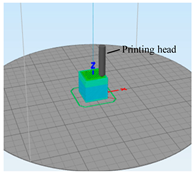 |
| Schematic cross section |  |
| Printing speed (mm ) | 60 |
| Platform Temperature (°C) | 60 |
| Sample (z = 1~10) | Average Measurements (μm) | Prediction (μm) | Errors (%) |
|---|---|---|---|
| 22.59 | 24.4 | 7.42 | |
| 23.28 | 4.59 | ||
| 24.07 | 1.48 |
| Sample (z = 1~10) | Average Measurements (μm) | Prediction (μm) | Errors (%) |
|---|---|---|---|
| 8.25 | 8.95 | 7.82 | |
| 8.58 | 4.13 | ||
| 9.34 | 4.36 |
| Sample (z = 1~10) | Average Measurements (μm) | Prediction (μm) | Errors (%) |
|---|---|---|---|
| 31.24 | 32.20 | 2.98 | |
| 32.80 | 1.86 | ||
| 33.65 | 4.50 |
| Sample (z = 1~10) | Average Measurements (μm) | Prediction (μm) | Error (%) |
|---|---|---|---|
| 5.40 | 5.80 | 6.89 | |
| 6.35 | 9.48 | ||
| 6.41 | 10.52 |
| Case | Default | Lower Value | Upper Value |
|---|---|---|---|
| 1. Extrusion width (mm) | 0.4 | 0.3/0.2 | - |
| 2. Extrusion temperature (°C) | 200 | 190 | 210 |
| 3. Layer thickness (mm) | 0.15 | 0.1 | 0.2 |
| Parameters | Minimum Value | Maximum Value | The Rates of Surface Roughness Growth (%) |
|---|---|---|---|
| Extrusion width (mm) | 0.2 | 0.4 | −13.17 |
| Extrusion temperature (°C) | 190 | 210 | −35.15 |
| Layer thickness (mm) | 0.1 | 0.2 | 56.74 |
Publisher’s Note: MDPI stays neutral with regard to jurisdictional claims in published maps and institutional affiliations. |
© 2022 by the authors. Licensee MDPI, Basel, Switzerland. This article is an open access article distributed under the terms and conditions of the Creative Commons Attribution (CC BY) license (https://creativecommons.org/licenses/by/4.0/).
Share and Cite
Jiang, S.; Hu, K.; Zhan, Y.; Zhao, C.; Li, X. Theoretical and Experimental Investigation on the 3D Surface Roughness of Material Extrusion Additive Manufacturing Products. Polymers 2022, 14, 293. https://doi.org/10.3390/polym14020293
Jiang S, Hu K, Zhan Y, Zhao C, Li X. Theoretical and Experimental Investigation on the 3D Surface Roughness of Material Extrusion Additive Manufacturing Products. Polymers. 2022; 14(2):293. https://doi.org/10.3390/polym14020293
Chicago/Turabian StyleJiang, Shijie, Ke Hu, Yang Zhan, Chunyu Zhao, and Xiaopeng Li. 2022. "Theoretical and Experimental Investigation on the 3D Surface Roughness of Material Extrusion Additive Manufacturing Products" Polymers 14, no. 2: 293. https://doi.org/10.3390/polym14020293
APA StyleJiang, S., Hu, K., Zhan, Y., Zhao, C., & Li, X. (2022). Theoretical and Experimental Investigation on the 3D Surface Roughness of Material Extrusion Additive Manufacturing Products. Polymers, 14(2), 293. https://doi.org/10.3390/polym14020293






